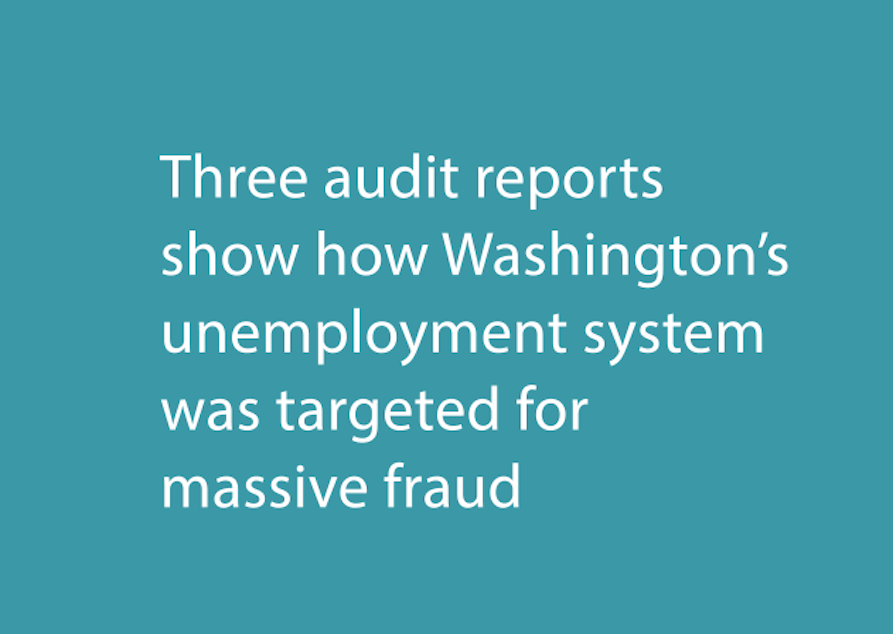Washington state auditor’s report details unemployment fraud

Last year Washington's Employment Security Department was hit by a massive fraud scheme. Hundreds of millions of dollars were siphoned off.
This week, the State Auditor's Office put out the results of their investigation into how this happened. KUOW’s Kim Malcolm spoke with Seattle Times reporter Jim Brunner about the findings.
This interview has been edited for clarity.
Kim Malcolm: What was the fraud scheme that targeted Washington's unemployment system last year?
Jim Brunner: Washington was one of the first states to experience the coronavirus pandemic, and hence our unemployment crisis hit a little sooner than some other states. A whole bunch of people were filing for unemployment last spring.
It quickly became apparent that there were also a bunch of scammers making false claims for unemployment. As we reported, a number of them were actually foreign cyber criminals. A Nigerian crime ring called Scattered Canary was logging into Washington’s system and filing thousands and thousands of fake unemployment claims, many of which were paid out to the tune of perhaps as much as $640 million.
Do we know how much money has been recovered?
The estimates are $370 million has been recovered. The Employment Security Department says it's continuing to work with banks and other institutions to try to get money back.
This was investigated by the state auditor's department. It found that Washington's unemployment agency was “wholly unprepared to prevent this.”
The auditor found that this was an unprecedented surge in unemployment, and in a way it would have been hard to prepare for the type of sophisticated attack, but the Employment Security Department had done things like upgrade their computer system, a $44 million software upgrade, that was supposed to help detect fraud, and it kind of failed in this regard.
The audit says the agency was more focused on run of the mill unemployment fraud, which occurs all the time. It isn't a foreign hacker trying to get into the system. It's maybe more mundane. It's people who are just trying to game the system for themselves or for a few people. It wasn't this widespread scheme that occurred.
You've previously reported that the agency had a lot of warning signs that it missed in the past.
There certainly were warning signs. We reported this last year. We talked to some cybersecurity experts who said that there were suspicious things going on in the Employment Securities portal. There were foreign IP addresses. There were suspicious email addresses that were jumping in there and opening all kinds of claims.
The agency eventually noticed this, but they didn't shut the door to these payments, which went out very quickly last spring, before hundreds and hundreds of millions of dollars went out the door. It created big news stories, eventually spawned these audits, and we're still working with the fallout of what's happening here.
What did the investigation find about how the agency actually performed under pandemic conditions?
The audits found what a lot of people know who've tried to deal with the Employment Security Department — that it was impossible to get through to the system for many people, for the vast majority of people, I would say. They're calling these call centers. They're getting put on hold. They were getting put on hold for an average of more than two hours at the peak last April.
It got a little better after that, but the audit report notes that it's still a big problem. People are still not able to get through. Every time we write a story about this we hear from more people who are saying "I can't get any answers. I can't get through on the phone. They're not responding to email. They're not responding to what I put through on the web portal." It's a big problem that continues.
Sponsored
How is the Employment Security Department responding to this audit?
The biggest dispute between the Employment Security Department and the state auditor has to do with the total amount of money that may have been lost due to fraud. The audit said that it could be as high as $1.1 billion once all the claims flagged for investigation are reviewed.
The Employment Security Department hit back very hard at that, saying there's no way it's as high as $1.1 billion, and they gave the auditor information to show that it cannot be that high. They say it’s down more in the $640 million range, which is still a lot.
The auditor said the data that the Employment Security Department provided didn't really satisfy them to prove that it wasn't that high. I don't know how that will work out but there's a dispute there.
Listen to the interview by clicking the play button above.





